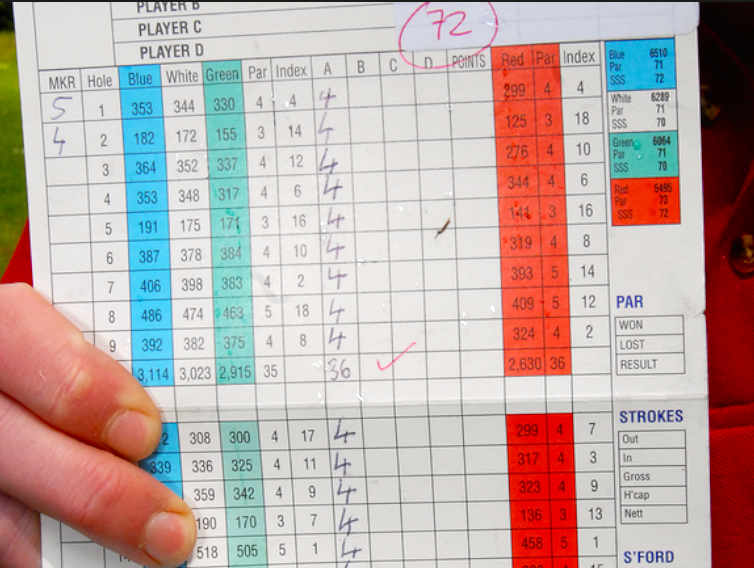Golf SSS And CSS Explained
SSS & CSS confuse many golfers. Here's a brief explanation and summary of the two concepts


For those who’ve never quite understood golf's Standard and Competition Scratch Scores (SSS and CSS), Jeremy Ellwood sums it up
Golf SSS And CSS Explained
SSS and CSS - where do we start?
Well, the first thing to stress is that SSS rather than par is the measurement against which handicaps are assessed, and even some golfers who have been playing for many years don’t understand this.
The reason for this is quite straightforward – some courses with the same overall par are simply much harder than others because of the make up of the individual holes or the difficulty of the terrain over which they play.
CONGU – the body who control the handicap system in the UK – describe SSS as “a measure of the playing difficulty of a golf course for a scratch golfer under normal mid-season course and weather conditions.”
A number of factors come into play over and above course length when the SSS of a course is evaluated, though length is a major factor.
Get the Golf Monthly Newsletter
Subscribe to the Golf Monthly newsletter to stay up to date with all the latest tour news, equipment news, reviews, head-to-heads and buyer’s guides from our team of experienced experts.
Other things taken into consideration include 10 ‘obstacle factors’ – topography, fairways, green target recoverability and rough, bunkers, out of bounds, extreme rough, water hazards, trees, green surface and psychological elements.
And four factors that can affect course playing length from day to day are also considered – amount of roll, wind, any forced lay-ups, and the number of doglegs and changes in elevation.
You may be thinking, why isn’t par good enough?
But if you think about it logically, par 3s can be anything from 90 to 249 yards, and par 4s anything from 250 to 500 yards.
Continues below
Expand How Do I Get A Golf Handicap?

How to obtain a CONGU handicap and the…
Expand How Are Golf Handicaps Adjusted?

How Are Golf Handicaps Adjusted?
Once you have a handicap, it is then…
Expand How Should Non-Member Handicaps Be Viewed?

How Should Non-Member Handicaps Be Viewed?
Currently, golfers who aren’t members of union-affiliated clubs…
The upper end of those extremes is clearly a considerably harder hole than the lower, so the relative difficulty must be taken into account via means other than par.
Taking an extreme example, let’s say Course A is made up of 18 300-yard par 4s and Course B 18 465-yard par 4s.
The player who shoots level par around the former won’t be as good a golfer as someone who shoots level par around the latter.
Some question the need for it; others just don’t understand how it works.
There isn’t space to go into the full details here, but CSS is a day-to-day variation in SSS against which handicap changes are based.
It ranges from one below SSS to three above according to the handicap make-up of the field and the scores returned.
This, in turn, should be a function of the difficulty or otherwise of playing conditions on the day.
As one golf club’s website sums it up: “The logic is simple. If scores on the day are generally very good you can assume that playing conditions were good. In that case it would be unfair to cut a player's handicap too much as some of the success was probably down to conditions.”
In other words it wasn’t a change in ability that allowed you to score well or forced you to struggle, but a variation in course conditions and difficulty. So it is only right that this is factored into the figure against which handicaps are assessed.
Don't forget to follow Golf Monthly on Facebook, Twitter and Instagram

Jeremy Ellwood has worked in the golf industry since 1993 and for Golf Monthly since 2002 when he started out as equipment editor. He is now a freelance journalist writing mainly for Golf Monthly. He is an expert on the Rules of Golf having qualified through an R&A course to become a golf referee. He is a senior panelist for Golf Monthly's Top 100 UK & Ireland Course Rankings and has played all of the Top 100 plus 91 of the Next 100, making him well-qualified when it comes to assessing and comparing our premier golf courses. He has now played 1,000 golf courses worldwide in 35 countries, from the humblest of nine-holers in the Scottish Highlands to the very grandest of international golf resorts. He reached the 1,000 mark on his 60th birthday in October 2023 on Vale do Lobo's Ocean course. Put him on a links course anywhere and he will be blissfully content.
Jezz can be contacted via Twitter - @JezzEllwoodGolf
Jeremy is currently playing...
Driver: Ping G425 LST 10.5˚ (draw setting), Mitsubishi Tensei AV Orange 55 S shaft
3 wood: Srixon ZX, EvenFlow Riptide 6.0 S 50g shaft
Hybrid: Ping G425 17˚, Mitsubishi Tensei CK Pro Orange 80 S shaft
Irons 3- to 8-iron: Ping i525, True Temper Dynamic Gold 105 R300 shafts
Irons 9-iron and PW: Honma TWorld TW747Vx, Nippon NS Pro regular shaft
Wedges: Ping Glide 4.0 50˚ and 54˚, 12˚ bounce, True Temper Dynamic Gold 105 R300 shafts
Putter: Kramski HPP 325
Ball: Any premium ball I can find in a charity shop or similar (or out on the course!)
-
 The Masters Crystal Rory McIlroy Has Already Won At Augusta National This Week
The Masters Crystal Rory McIlroy Has Already Won At Augusta National This WeekMcIlroy leads going in to the final round at Augusta National, with the four-time Major winner already bagging some silverware before he looks to claim the Green Jacket
By Matt Cradock Published
-
 Rory McIlroy Has Referenced Scottie Scheffler So Often In Recent Months… Is He Now Finally Ready To Surpass Him?
Rory McIlroy Has Referenced Scottie Scheffler So Often In Recent Months… Is He Now Finally Ready To Surpass Him?For several months, Rory McIlroy revealed how he was aiming to be more like Scottie Scheffler in 2024 - and it now appears as though the World No.2 is doing it
By Jonny Leighfield Published